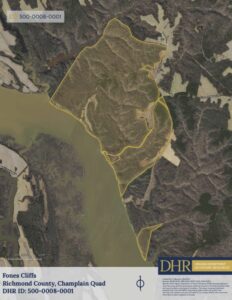On Wednesday, the Rappahannock Tribe acquired the largest amount of its ancestral lands to date with the transfer of nearly 1,000 acres from The Conservation Fund, to be preserved in perpetuity under easement with the U.S. Fish and Wildlife Service and the Virginia Board of Historic Resources.
All but a sliver of the four-mile stretch of shoreline that makes up Fones Cliffs, a cultural and ecological treasure that is the location of the tribe’s historic homeland, is now protected. The area is the habitat of one of the largest concentrations of nesting bald eagles along the Atlantic coast.
“Tribal citizens will once again, after 350 years of being separated from their mother, the Rappahannock River, have unimpeded opportunities to practice life-sustaining traditions,” said Patricia Morris, the Rappahannock Tribe’s marketing coordinator, via email. “Hunting, fishing, and ceremonies can resume on the lands where their ancestors are buried.”

The tribe will co-steward the land with the Rappahannock River Valley National Wildlife Refuge, whose goal is to protect 20,000 acres of wetlands and its associated uplands along the Rappahannock River and its major tributaries.
“We’re just real thrilled that this property is back in the hands of the people that will care for it best,” said Heather Richards, The Conservation Fund’s vice president for the Mid-Atlantic Region.
The preservation of an additional 1,000 acres will add to what is a “…very significant contiguous block of land that’s now managed for wildlife and native habitat, and that in and of itself is remarkable just in terms of the size of it and also the uniqueness of the cliffs,” said Richards.
A return to their homeland
The Rappahannock people’s roots stretch back centuries before Virginia was first colonized by Europeans, and research has confirmed their presence on the ancient lands surrounding Fones Cliffs.
“Before colonization, limited archeological and historical evidence suggests people were in the river valley 10,000 years ago,” said Morris. “Captain John Smith found at least forty-three densely populated communities, indicating rich if unknown history.”
The Rappahannock people’s way of life was “centered around the river – fishing, oysters, hunting, agriculture, pottery, basket weaving, fish traps, and netting – all of which was based on the natural resources of the river,” Morris said.
When colonization and development displaced the tribe, forcing them inland,“it was miles away from the tribe’s life-sustaining practices,” Morris said. “The spiritual connection to the river was lost, devastating the culture and changing the history of the tribe’s struggle to survive.”
The tribe’s return to the river is the culmination of years of effort to acquire the land, which Morris said “felt a lot like climbing a mountain while carrying a moon-sized shopping bag of moving parts and pieces.”
The land transfer marks the second major acquisition of land by the tribe along the Rappahannock River in recent years. In 2022, the tribe celebrated its rematriation to 465 acres of land bordering the waterway.
Rappahannock Tribe celebrates return of Fones Cliffs acreage
The Rappahannock Tribe will now have opportunities to expand its Return to the River program, which trains tribal youth in traditional river knowledge and practices.
The tribe is also planning to build a small visitors’ center on the newly acquired land, new pow wow grounds, walking trails and public education and recreation opportunities through a grant from the American Environmental Restoration Initiative and the National Fish and Wildlife Foundation.
Not an easy win
Just over two years ago, the fate of the land was entirely unknown. It was in the hands of the Virginia True Corporation, a developer with big plans for the property, including the construction of an 18-hole golf course, a resort subdivision, luxury condos and federally funded housing.
In 2022, the Virginia True Corporation put the property up for public auction as a result of bankruptcy proceedings. The Conservation Fund was the highest bidder in the public auction for the land and successfully acquired the property for $8.1 million.
Then came more than two years of efforts to secure the funding needed to conserve the land through an easement with the U.S. Fish and Wildlife Service before it could be transferred into the possession of the Rappahannock Tribe.
After some “ordinary” delays in that process, the easement was completed in December of last year, and The Conservation Fund was “able to move pretty quickly to get the fee title into the hands of the tribe,” said Richards.
River worries
The tribe’s long-awaited return to the River comes at a time of great concern for the health of the Rappahannock River itself. This week, it was designated as the sixth most endangered river in the U.S. by the nonprofit American Rivers.
The nonprofit stated that “increased strain on water resources and the absence of unified water management threaten the river’s ability to meet the needs of both people and nature.”
Recently, counties along the Rappahannock River have requested to withdraw more water from it than ever before in response to residential, commercial and industrial growth in the region, raising concern amongst indigenous leaders and conservationists.
The Rappahannock River stretches roughly 200 miles from the Blue Ridge Mountains to the Chesapeake Bay and supports a diverse range of ecosystems that provide critical habitat for fish and wildlife, according to American Rivers.
Richards said that the struggle overFones Cliffs has taught her that with the right team and perseverance, “we can actually make some really big inroads on protecting the river and really enhancing and restoring it.”
NEWSLETTER SIGNUP
Subscribe to our newsletter! Get updates on all the latest news in Virginia.



